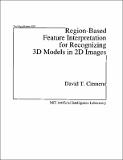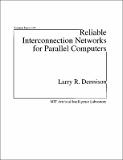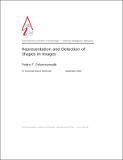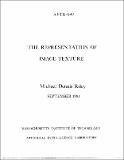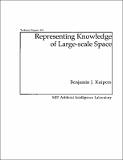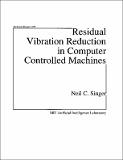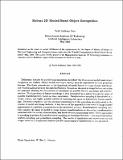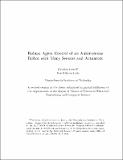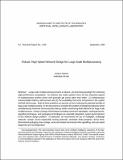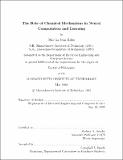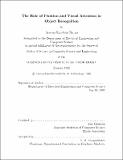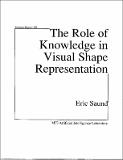Browsing AI Technical Reports (1964 - 2004) by Title
Now showing items 233-252 of 327
-
Reflectance Map Techniques for Analyzing Surface Defects in Metal Castings
(1978-06-01)This report explores the relation between image intensity and object shape. It is shown that image intensity is related to surface orientation and that a variation in image intensity is related to surface curvature. ... -
Region-Based Feature Interpretation for Recognizing 3D Models in 2D Images
(1991-06-01)In model-based vision, there are a huge number of possible ways to match model features to image features. In addition to model shape constraints, there are important match-independent constraints that can efficiently ... -
Reinforcement Learning by Policy Search
(2003-02-14)One objective of artificial intelligence is to model the behavior of an intelligent agent interacting with its environment. The environment's transformations can be modeled as a Markov chain, whose state is partially ... -
A Reinforcement-Learning Approach to Power Management
(2002-05-01)We describe an adaptive, mid-level approach to the wireless device power management problem. Our approach is based on reinforcement learning, a machine learning framework for autonomous agents. We describe how our ... -
Reliable Interconnection Networks for Parallel Computers
(1991-10-01)This technical report describes a new protocol, the Unique Token Protocol, for reliable message communication. This protocol eliminates the need for end-to-end acknowledgments and minimizes the communication effort ... -
Representation and Detection of Shapes in Images
(2003-08-08)We present a set of techniques that can be used to represent and detect shapes in images. Our methods revolve around a particular shape representation based on the description of objects using triangulated polygons. This ... -
The Representation of Image Texture
(1981-09-01)This thesis explores how to represent image texture in order to obtain information about the geometry and structure of surfaces, with particular emphasis on locating surface discontinuities. Theoretical and psychophysical ... -
Representing and Reasoning About Change in Geologic Interpretation
(1983-12-01)Geologic interpretation is the task of inferring a sequence of events to explain how a given geologic region could have been formed. This report describes the design and implementation of one part of a geologic interpretation ... -
Representing Knowledge of Large-Scale Space
(1977-07-01)This dissertation presents a model of the knowledge a person has about the spatial structure of a large-scale environment: the "cognitive map". The functions of the cognitive map are to assimilate new information about ... -
Residual Vibration Reduction in Computer Controlled Machines
(1989-02-01)Control of machines that exhibit flexibility becomes important when designers attempt to push the state of the art with faster, lighter machines. Three steps are necessary for the control of a flexible planet. First, ... -
Robot Motion Vision by Fixation
(1992-09-01)In many motion-vision scenarios, a camera (mounted on a moving vehicle) takes images of an environment to find the "motion'' and shape. We introduce a direct-method called fixation for solving this motion-vision problem ... -
Robust 2-D Model-Based Object Recognition
(1988-05-01)Techniques, suitable for parallel implementation, for robust 2D model-based object recognition in the presence of sensor error are studied. Models and scene data are represented as local geometric features and robust ... -
Robust Agent Control of an Autonomous Robot with Many Sensors and Actuators
(1993-05-01)This thesis presents methods for implementing robust hexpod locomotion on an autonomous robot with many sensors and actuators. The controller is based on the Subsumption Architecture and is fully distributed over ... -
Robust and Efficient 3D Recognition by Alignment
(1992-09-01)Alignment is a prevalent approach for recognizing 3D objects in 2D images. A major problem with current implementations is how to robustly handle errors that propagate from uncertainties in the locations of image ... -
Robust Photo-topography by Fusing Shape-from-Shading and Stereo
(1993-02-01)Methods for fusing two computer vision methods are discussed and several example algorithms are presented to illustrate the variational method of fusing algorithms. The example algorithms seek to determine planet ... -
Robust, High-Speed Network Design for Large-Scale Multiprocessing
(1993-09-01)As multiprocessor system size scales upward, two important aspects of multiprocessor systems will generally get worse rather than better: (1) interprocessor communication latency will increase and (2) the probability ... -
The Role of Chemical Mechanisms in Neural Computation and Learning
(1995-05-23)Most computational models of neurons assume that their electrical characteristics are of paramount importance. However, all long-term changes in synaptic efficacy, as well as many short-term effects, are mediated by ... -
The Role of Fixation and Visual Attention in Object Recognition
(1995-07-21)This research project is a study of the role of fixation and visual attention in object recognition. In this project, we build an active vision system which can recognize a target object in a cluttered scene efficiently ... -
The Role of Knowledge in Visual Shape Representation
(1988-10-01)This report shows how knowledge about the visual world can be built into a shape representation in the form of a descriptive vocabulary making explicit the important geometrical relationships comprising objects' shapes. ... -
Roles of Knowledge in Motor Learning
(1987-02-01)The goal of this thesis is to apply the computational approach to motor learning, i.e., describe the constraints that enable performance improvement with experience and also the constraints that must be satisfied by ...


